- SAP Functions


SAP Business Planning and Consolidation: Streamlining Financial Processes
In today’s fast-paced business environment, effective financial planning and consolidation are critical for an organization’s success. Companies need to make informed decisions, allocate resources efficiently, and ensure compliance with ever-evolving regulations. SAP Business Planning and Consolidation (BPC) is a powerful solution that can help streamline financial processes, providing businesses with the tools they need to thrive in a competitive landscape.

1. The Importance of Financial Planning and Consolidation
Financial planning and consolidation involve the management of an organization’s financial data to make strategic decisions, allocate resources, and report on performance. These processes are vital for several reasons:
1.1. Informed Decision-Making
Financial planning allows organizations to set clear objectives and create a roadmap for achieving them. By analyzing historical data and market trends, businesses can make informed decisions about investments, cost management, and revenue generation.
1.2. Resource Allocation
Efficient allocation of resources, such as capital, labor, and materials, is essential for optimizing operations and maximizing profitability. Financial planning helps organizations allocate resources where they are needed most.
1.3. Compliance and Reporting
Regulatory bodies require accurate and timely financial reporting. Failure to comply with regulations can lead to legal issues and damage a company’s reputation. Financial consolidation ensures that financial data is accurately collected, validated, and reported.
1.4. Performance Monitoring
Monitoring financial performance is crucial for identifying strengths and weaknesses within an organization. Regular financial reporting and analysis enable businesses to make necessary adjustments to improve performance.
2. Challenges in Financial Planning and Consolidation
Despite the importance of financial planning and consolidation, many organizations face challenges in these areas. Common challenges include:
2.1. Data Complexity
Financial data is often spread across multiple systems, making it difficult to consolidate and analyze. Data complexity can lead to errors and delays in the financial reporting process.
2.2. Manual Processes
Many organizations still rely on manual data entry and spreadsheet-based solutions for financial planning and consolidation. These processes are time-consuming and error-prone.
2.3. Lack of Integration
Disconnected systems and data silos hinder the seamless flow of financial information. This lack of integration can lead to discrepancies and inefficiencies.
2.4. Compliance Risks
Meeting regulatory requirements can be challenging without a robust consolidation and reporting system. Non-compliance can result in financial penalties and damage to a company’s reputation.
3. SAP Business Planning and Consolidation (BPC) – A Solution for Streamlining Financial Processes
SAP BPC is a comprehensive solution designed to address the challenges associated with financial planning and consolidation. It offers a wide range of features and benefits that can transform your organization’s financial processes.
3.1. Unified Platform
SAP BPC provides a unified platform for financial planning, budgeting, forecasting, and consolidation. With all your financial data in one place, you can eliminate data silos and improve data accuracy.
3.2. Integration with SAP and Non-SAP Systems
SAP BPC seamlessly integrates with other SAP solutions and non-SAP systems, ensuring that you can access all your financial data from a single source. This integration simplifies data collection and reporting.
3.3. Automation and Workflow
SAP BPC automates many financial processes, reducing the need for manual data entry and calculations. This automation not only saves time but also reduces the risk of errors.
3.4. Real-time Reporting and Analytics
With SAP BPC, you can access real-time financial data and generate reports and analytics instantly. This capability empowers your organization to make data-driven decisions promptly.
3.5. Compliance and Security
SAP BPC helps ensure compliance with financial regulations by providing built-in controls and audit trails. Your data is also secure with role-based access controls and encryption.
3.6. Scalability
SAP BPC is scalable and can grow with your organization. Whether you are a small business or a large enterprise, SAP BPC can accommodate your financial planning and consolidation needs.
4. How SAP BPC Streamlines Financial Processes
Let’s explore some key ways in which SAP BPC streamlines financial processes with code samples and examples.
4.1. Automated Data Collection
SAP BPC allows you to automate the collection of financial data from various sources, such as ERP systems, spreadsheets, and external databases. This automation reduces the risk of manual errors and ensures data accuracy.
4.2. Dynamic Budgeting and Forecasting
With SAP BPC, you can create dynamic budgets and forecasts that take into account changing market conditions. The system can automatically adjust forecasts based on real-time data.
4.3. Consolidation and Elimination
SAP BPC simplifies the consolidation process by providing pre-built templates and automated elimination rules. This streamlines the creation of consolidated financial statements.
4.4. Real-time Reporting
SAP BPC offers real-time reporting capabilities, allowing you to generate financial reports instantly. You can create customized dashboards and reports to visualize your data effectively.
4.5. Collaboration and Workflow
SAP BPC includes collaboration features that enable multiple stakeholders to work on budgets, forecasts, and reports collaboratively. Workflow management ensures that tasks are completed efficiently.
Case Study: How Company XYZ Streamlined Financial Processes with SAP BPC
To illustrate the real-world impact of SAP BPC, let’s take a look at a fictional case study involving Company XYZ.
Company XYZ is a medium-sized manufacturing company with operations in multiple countries. They were facing challenges in their financial planning and consolidation processes, including:
- Manual data collection from different subsidiaries.
- Lengthy and error-prone consolidation processes.
- Lack of real-time visibility into financial data.
Company XYZ implemented SAP BPC to streamline their financial processes. Here’s how they benefited:
- Automated Data Collection: They automated data collection from various subsidiaries and integrated it into SAP BPC, reducing the time spent on data entry.
- Real-time Reporting: SAP BPC provided real-time visibility into financial data, enabling the finance team to generate reports and forecasts on-demand.
- Consolidation: The consolidation process became more efficient, with automated elimination rules ensuring accuracy.
- Dynamic Forecasting: Company XYZ used SAP BPC’s dynamic forecasting capabilities to adjust their budgets and forecasts based on changing market conditions.
- Compliance: The built-in controls and audit trails in SAP BPC helped Company XYZ ensure compliance with financial regulations.
By implementing SAP BPC, Company XYZ achieved the following results:
- Reduced the time spent on financial processes by 30%.
- Improved data accuracy, reducing errors in financial reporting.
- Enabled timely and data-driven decision-making.
- Streamlined collaboration among finance teams in different regions.
SAP Business Planning and Consolidation (BPC) is a powerful solution that can revolutionize your organization’s financial processes. Whether you’re a small business or a large enterprise, SAP BPC offers the tools and capabilities you need to streamline financial planning, consolidation, and reporting. By automating manual processes, providing real-time data visibility, and ensuring compliance, SAP BPC empowers your organization to make informed decisions and achieve financial success in today’s competitive landscape.
If you’re ready to take your financial processes to the next level, consider implementing SAP BPC and unlock the full potential of your organization’s financial data. Say goodbye to manual data entry, errors, and delays, and embrace a streamlined and efficient financial future with SAP BPC.

Table of Contents

SAP Project System: Managing Projects and Resources Effectively
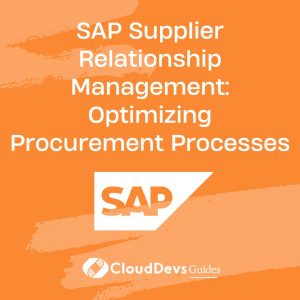
SAP Supplier Relationship Management: Optimizing Procurement Processes
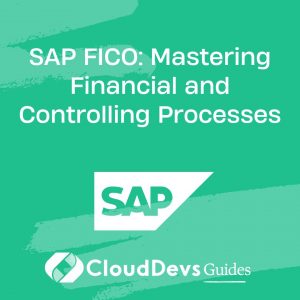
SAP FICO: Mastering Financial and Controlling Processes

SAP Analytics Cloud Planning and Group Reporting are the Next Generation of Planning and Consolidation
Business Planning and Consolidation (BPC) has long been SAP’s flagship product for planning and consolidation. With SAP’s market strategy of going to the cloud, SAP Analytics Cloud (SAC) Planning and Group Reporting are now the preferred platforms over BPC. One of the strengths and value propositions of BPC was to have one integrated solution for consolidations and planning. At first glance, it might appear that the once-integrated solution has been separated into two solutions, especially given the fact that there are two different products names. But this couldn’t be further from the truth. While it is true SAC is a separate product, the reality is that SAC Planning has joined a product with much greater overall capabilities. When compared to BPC, SAC is an all-encompassing product with BI, predictive, analytics and a wide variety of connections to the entire enterprise. It is a comprehensive platform, with planning being one of many features. The ability to connect to most systems has significant advantages in that planning and forecasting can be applied to any number of areas (e.g., HR, marketing, sales and operational planning) as compared to focusing only on financial planning. This flexibility coupled with the breadth of capabilities in SAC, provides for a much more powerful planning and reporting tool.
So where does consolidation come to play in this scenario? With Group Reporting, SAP has embedded the consolidation engine into the core S/4HANA system. Group Reporting is used to do the core consolidation of entities with additional functionality such as currency conversion, equity ownership calculations, intercompany eliminations, balance carryforward, currency translation adjustments and many others.
Group Reporting consolidation features (and how they relate to SAC) include:
- Uses both SAP or non-SAP data, as does SAC.
- Creates several versions of data for comparisons of pre- and post-consolidation data, joining it with other data (e.g., simulations, forecasting and restatement) using SAC analytics. It also unlocks hidden insights and predictive capabilities.
- Embedded monitors help perform consolidation tasks such as various interunit eliminations and data validation. This feature is enhanced by using SAC as a source to drill into the details of S/4HANA and other source systems.
- While SAP S/4HANA universal journal is usually the source and data are processed, Group Reporting’s limited capabilities will be enhanced using SAC as the reporting and analytics engine.
- Data may be loaded with flat files or APIs from any source system. SAC can also be used as a source to generate these flat files and can cleanse and reconcile data between source systems.
- Post manual journal entries to standardize reported data but SAC should be used to report on this data. SAC is more flexible and user friendly, allowing for greater enrichment capabilities.
- Validations check the consistency of data throughout the consolidation process, using comments and linked reports functions.
- Translate reported financial data into the group currency and allow SAC to report data on transaction, local, group and reporting currency.
- Automate interunit eliminations, consolidation of investments and perform the elimination and consolidation and utilize SAC to perform the analytics on the data.
- Automate consolidation of investments.
- Deliver frequently used reports out of the box as analytical apps including balance sheets, P&L statements, cash flow statements or statements of comprehensive income and statements of changes in equity. Use SAC where necessary to pick up where Group Reporting falls short.
As expected, SAP delivers robust out of the box consolidation functionality to handle any use case, no matter how complex. This comprehensive set of capabilities give companies the ability to quickly and efficiently roll up consolidated results in S/4HANA. Once there, SAC can be used as the primary reporting engine for consolidated reports (e.g., P&L, balance sheet, cash flow). In this way, SAC and Group Reporting are an integrated platform, with GR being the consolidation engine and SAC the mechanism that delivers the output. Ultimately, the solution provides for a fully integrated system with planning, actual and consolidated data using one platform in real time.

One advantage of this new paradigm is that instead of having a system limited to integrated financial planning and consolidations, the solution now consolidates all data in an organization, giving a much more comprehensive view of results, deeper analysis and the ability to see relationships across the company. This can also include multiple source systems such as legacy systems, multiple financial systems (e.g., ECC, S/4HANA, CFIN, BPC, etc.) and other non-SAP and SAP systems. These additional capabilities allow for broader, more impactful insights; for example, how do marketing activities relate to sales? Or, how does employee satisfaction and performance impact employee cost and financial results? Using a powerful predictive and machine learning engine, different and disparate sources can be analyzed, leading to a deeper understanding of a company’s performance. And of course, this all ties into planning and consolidation where overall company results are combined to see results of operations for total net income, statement of cash flow and status of balance sheet.
As companies continue to assess cloud strategies, simplification, and enhanced analytics capabilities, the combination of SAC Planning and Group Reporting can deliver tremendous benefits. In addition, this approach is in line with SAP’s strategy for the intelligent enterprise. This combination allows companies to align resources across the enterprise, from sales, marketing and human resources to operations and production, enabling integrated financial consolidated results. Organizations can use the planning and forecasting process to not only predict results, but to identify new opportunities to help drive future growth and profitability.

To summarize, SAP is converging its platform so that users have all relevant information at their fingertips. From operational data to strategic information, from management reporting views to consolidated financials. All are related and critical for organizations to understand key challenges, risk, and opportunities so that decisions can be made, and actions taken to enhance results. SAC Planning and Group Reporting are a cornerstone to this process and take planning and consolidation to the next level in delivering unprecedented value.
To learn more about our SAP Analytics Cloud capabilities , contact us .

Associate Director Enterprise Application Solutions

Senior Manager Technology Consulting
Add comment
Cancel reply.

SAP Business Technology Platform Demystified
In the early days of software development, new business requirements typically meant starting from the ground up. In an integrated development environment, a new project was added, connections to data were established...
Case Study: Selecting a Conversion Type for SAP BW/4HANA Migration
An SAP BW/4HANA migration is a significant investment for any organization. With several migration options available, selecting the right one will reduce project risk, streamline the timeline and can even eliminate long...
Leveraging SAP Analytics Cloud Planning to Streamline FP&A Processes, Unlock New Capabilities
Like many companies undergoing a digital transformation, Protiviti’s experts recently assisted a national financial services company struggling with error-prone Financial Planning and Analysis (FP&A) processes...
Subscribe Now
Recent posts.
- Navigating the Shift: Insights from Upgrading to HANA Cloud Platform
- Next-Level Reporting: Managed Services Revolutionize SAP GRC Access Control Operations
- Manufacturing Client Story: Data Excellence Paves the Way to S/4HANA Readiness
- There’s a Bright Future for SAP BusinessObjects 4.3 and Beyond
- Consumer Products Client Story: Multinational Company Modernizes Financial Planning and Analysis with SAP Analytics Cloud
Recent Comments
- Sujoy Roychowdhury on Modeling with SAP Infinite Insight
- Sponsored By: Decision First Technologies on SAP Predictive Analysis Installation
- Sujoy Roychowdhury on SAP Predictive Analysis Installation
- Our Services
- Central Finance
- Data Management
- Industry Trends
- Astute Finance
- SAP S/4 HANA
- SAP Analytics Cloud
- ERP Transformation
- SAP S/4 HANA Group Reporting
- SAP EPM Consulting & Development
- Solution Architecting & Design
- Dedicated Project Teams
- Project Staff Augmentation
- SAP Partner Project Staffing
- Project Management
- Enterprise Performance Management
- Business Planning & Consolidation
- Realtime Analytics & Dashboards
- Partnerships and Recognitions
Enterprise Planning, Budgeting, Forecasting and Consolidation in a Single Solution
SAP BPC (Budget Planning & Consolidation) is a key component of SAP’s EPM suite that offers enterprise budget planning and consolidation tools that simplify the enterprise budget planning process and help measure ongoing corporate performance against forecasts. It allows what-if forecasting, helps accelerate budget and closing cycles and ensures compliance with financial reporting standards.
AstuteOne’s team has over 10 years’ experience working with enterprise companies to design and implement their BOC environment. Our professional services team can help you plan, launch and enhance your BPC solution and ensure your team is fully enabled to leverage it to the fullest extent. Contact your AstuteOne representative or contact us below to arrange time to discuss how to get started.
SAP BPC’s Functional Capabilities
Unified planning and consolidation.
Single, integrated software solution for business planning and consolidation saves time and reduces errors.
Microsoft Office, Web, and mobile reporting
Familiar Microsoft Excel, HTML5, and mobile reporting interfaces keep stakeholders engaged across finance and throughout the enterprise.
Budgeting and forecasting
Assess budget suitability in real time using what-if modelling and scenario planning. Build forecast models and quickly update and adjust forecasts as needed.
Built-in financial intelligence
Accelerate planning cycles by automating aggregations, allocations, and other manual processes. Run what-if scenarios to identify quick course corrections.
Legal and management consolidations
Deliver a fast and accurate close by automating the consolidation process. Meet all financial reporting requirements, including a complete audit trail.
Pre-packaged Business Planning and Consolidation content
Rapidly implement a best-in-class solution with prepackaged industry and functional content for all types of planning – from capital to strategic planning. Take advantage of financial consolidation starter kits for IFRS and U.S. GAAP regulations.

Self-reliance and accountability
Foster self-reliance among business users by providing them with a finance tool built specifically for finance – and managed by finance.
SAP BPC’s Technical Capabilities
Unified with sap erp.
Reduce data duplication and cost of ownership by leveraging existing data warehouse objects. Ensure consistency across the enterprise with direct access to master data and actuals in SAP Business Suite powered by SAP HANA and SAP S/4HANA Finance.
Powered by SAP HANA
Accelerate planning and consolidation processing with SAP Business Planning and Consolidation, version for SAP NetWeaver. Leverage blazing fast in-memory technology to remove calculation delays from the critical path.
Available in the cloud
Harness the power of SAP HANA Enterprise Cloud to cut costs and deploy SAP Business Planning and Consolidation software in a managed cloud environment.
Open integration
Seamlessly integrate data and master data from both SAP and non-SAP sources into your financial planning and consolidation environment.
- SAP Global Trade Services (GTS)

Customer Stories
Meliá Hotels International: Connecting data from on-premise systems and third-party cloud software with analytics solutions
Explore meliá hotels international’s journey with sap.
Meliá Hotels International is one of the largest hotel groups in the world. It wanted to integrate the data from on-premise and third-party systems with its cloud solutions to enable centralized planning and reporting. The group’s analytics architecture now comprises the SAP Datasphere and SAP Analytics Cloud solutions to meet this need.
data-source connections to the SAP Datasphere solution.
hours to connect a new data source to SAP Datasphere.
sustainability and social KPIs centralized in SAP Datasphere.
We have a lot of different SAP and third-party data sources and technology tools at Meliá Hotels International. With the SAP Datasphere solution, we can easily integrate information from our on-premise and third-party software with our cloud systems and carry out cross analytics.
Laura Molino Roca Data Insight Lead, Meliá Hotels International
Integrating disparate systems to build a business data fabric
Founded in 1956, Meliá Hotels International (MHI) is a leading Spanish hotel group that has grown into one of the largest and most respected hotel chains worldwide. It operates a diverse portfolio of more than 340 luxury and escape hotels and resorts in 45 countries, and it employs over 39,000 people. Several of its brands cater to different areas of the hospitality market, reflecting the company’s strategy of growth and its focus on the luxury and premium segment.
To remain competitive, MHI continues to modernize its systems. Having previously used SAP BW/4HANA and SAP Analytics Cloud solutions, the company needed a product with tight integration to both. Additionally, it was important to gain smooth connectivity between the on-premise SAP products and third-party cloud-based software it used, such as Amazon Web Services (AWS) and Microsoft Azure, and its in-house cloud solutions. It wanted to be able to integrate these data sources with its planning and reporting processes. So, the group’s data and advanced analytics department carried out several proof-of-concept projects with software providers.
When we were introduced to the SAP Datasphere solution, we realized straightaway that the product could cover our business needs. It very quickly provided us with new connections to the cloud environments we work in every day.
Embedding advanced analytics into the IT architecture
Meliá Hotels International began using analytics tools more than 20 years ago when it adopted the SAP Business Warehouse application to manage its financial, budgeting, and purchasing information. It gradually upgraded to the SAP BW/4HANA solution that it uses today. The proof-of-concept projects yielded strong interest in the SAP Datasphere and SAP Analytics Cloud solutions to meet the group’s new needs in data warehousing, consolidation, planning, and reporting. It recognized the high potential of these solutions as self-service tools for advanced analytics, especially in the HR and ESG (environmental, social, and governance) areas. The two offerings now form the group’s analytics architecture.
SAP Datasphere offers native integration with SAP BW/4HANA, where financial data is kept. And it enables connectivity and cross analytics with information from SAP and third-party software and reporting tools, such as SAP Analytics Cloud and Microsoft Power BI. MHI has produced an internal HR model in SAP Datasphere and its first dashboard version in SAP Analytics Cloud. With this, the HR department now has a better overview of employee recruitment and training and can more easily analyze and drill down into that data with regard to each hotel. Also, employees can work with the tools they prefer, such as SAP Analysis for Microsoft Office software.
After implementation, the group carried out a project to connect the two analytics solutions with its ecosystem, including the SAP ERP application, SAP SuccessFactors solutions, and the SAP Business Planning and Consolidation application, version for SAP BW/4HANA.
IBSap Consulting S.L. supports MHI in the basic tasks necessary to create data-source connections and single-sign-on configurations. SDG Group developed HR models in SAP Datasphere and stories in SAP Analytics Cloud. And AC eSolutions developed sustainability models and stories in SAP Analytics Cloud for ESG annual reporting.
SAP has been our partner for many years, and SAP Datasphere and SAP Analytics Cloud have future-proofed our analytics architecture. With these cloud solutions, we can continue to stay competitive by leveraging our data strategically and maximizing its value.
Javier Gambín Manzano Senior SAP BW/4HANA BI Consultant, Meliá Hotels International
Streamlining and centralizing planning activities
One of the main advantages for Meliá Hotels International of using SAP Datasphere is the centralization of information in one place for planning and reporting. Also, the data can be displayed to users through different service models depending on their needs. By connecting SAP Datasphere with SAP SuccessFactors solutions, the group’s HR master data can be maintained in the data warehousing cloud solution, SAP BW/4HANA.
MHI is developing a global project to assess the analytics reporting in SAP SuccessFactors offerings, including the SAP SuccessFactors Employee Central, SAP SuccessFactors Recruiting, and SAP SuccessFactors Performance & Goals solutions. The project started with the business content offered by SAP Datasphere and adapted to the group’s needs. The development model created in SAP Datasphere was enriched with data from sources external to SAP SuccessFactors, such as the Cornerstone Talent Experience platform or e-Motiva, to provide timely and current information. In addition, the business connected the model with previously created Microsoft Power BI dashboards to analyze their performance and information.
With SAP Datasphere, we’re now able to take charge of our landscape and provide easy and intuitive access to quality data to business users. With business data at their fingertips, our lines of business can now innovate faster and drive better decisions.
Accommodating planning activities under one roof
Meliá Hotels International plans to gradually integrate SAP Datasphere into its analytics processes. It’s involving the main business units as part of the adaptation plan and aligning with its supply-side platform evolution. The group hopes to deliver its information-reporting project before the end of the year, based on the development data model and using sustainability data from SAP BW/4HANA. And it’s working to migrate customer relationship management data from third-party software to SAP BW/4HANA using SAP Datasphere. Next year, the main objective is to integrate new business data for self-service models for MHI analysts. The group is also considering an internal control system for nonfinancial information.
In 2025, the group intends to conduct proof of concepts for SAP Analytics Cloud for planning. It will use the data in SAP Datasphere to evaluate the migration from the embedded SAP Business Planning and Consolidation, version for SAP BW/4HANA to the planning capabilities. For secure file transfer protocol (SFTP) development, it’s hoping to use the planning capabilities to save data in SAP Datasphere instead of SAP Analytics Cloud, allowing the data to be combined with other information types. The group would ultimately like to have all planning activities carried out with SAP software.
After the planned migration of its ERP system to SAP S/4HANA, MHI will be able to connect the management of data loads from the core data services (CDS) views of SAP S/4HANA to the operational data provisioning (ODP) report directly through SAP Datasphere. And it will move group reporting from SAP Analysis for Microsoft Office to the cloud ERP.
Featured partners
IBSap Consulting S.L. has been partnering with MHI for 10 years, developing different projects with SAP Business Warehouse and SAP Business Planning and Consolidation applications.
SDG Group started working with MHI three years ago, helping the company with a proof of concept for the SAP Datasphere solution.
AC eSolutions, a Spanish company that provides experience and knowledge in data and analytics products and services, has worked with MHI for 12 years.
Explore more customer stories
- Find customer stories relevant to your business
Integrating SAP Analytics Cloud with SAP Business Planning and Consolidation Standard
.png&w=3840&q=75)
In this live session you will see how to import data from SAP Business Planning and Consolidation (BPC) Standard to create new models, or to add data to existing models. The session will also use SAP Analytics Cloud as a BPC client extension, rather than the EPM Add-In, enhancing BPC data with SAC ' s advanced analysis and forecasting tools, and then exporting it back to BPC.
Learning objectives
Your current experience in this topic.
Intermediate
Discover new Live Sessions

- Artificial Intelligence
- Generative AI
- Business Operations
- Cloud Computing
- Data Center
- Data Management
- Emerging Technology
- Enterprise Applications
- IT Leadership
- Digital Transformation
- IT Strategy
- IT Management
- Diversity and Inclusion
- IT Operations
- Project Management
- Software Development
- Vendors and Providers
- Enterprise Buyer’s Guides
- United States
- Middle East
- España (Spain)
- Italia (Italy)
- Netherlands
- United Kingdom
- New Zealand
- Data Analytics & AI
- Newsletters
- Foundry Careers
- Terms of Service
- Privacy Policy
- Cookie Policy
- Copyright Notice
- Member Preferences
- About AdChoices
- Your California Privacy Rights
Our Network
- Computerworld
- Network World
SAP forecasts clarity in the cloud
After customers and user groups that adopted s/4hana early accused sap of bait-and-switch tactics, cio editor-in-chief in germany martin bayer recently sat with christian klein, ceo of the multinational software company, to clear the air on cloud reassurance, using gen ai as a migration accelerant, and positive growth for the future..

Martin Bayer: At the moment, user companies are still hesitant to adopt cloud computing, but also SAP’s RISE and GROW programs, especially in Germany. Last year’s message that certain core innovations would only be offered in the cloud has also caused some resentment among users. How do you want to take your customers with you on their journey?
Christian Klein: I understand there’s some reluctance among [German-speaking SAP user group] DSAG and some other customers to embrace the cloud. But we have a strong cloud result. This indicates that many customers in Germany are also transitioning to the cloud. And even the companies that have heavily invested in SAP on-premise for years are moving to the cloud, with Microsoft Teams and Microsoft 365 — best-of-breed applications — or they host their ERP systems.
I don’t know of any customer who doesn’t use the cloud somewhere in their IT landscape. SAP has a legacy of on-premise systems. That’s why we also say we won’t switch over tomorrow. We’ve made a long-term maintenance commitment for on-premise applications. We won’t change that.
But how are you going to convince your clients to journey to the cloud?
We created incentives that take into account the previous investments our customers made in our solutions. That’s the commercial aspect. In addition, we’re investing in our tools with generative AI to facilitate migration. More importantly, and this is something we’ve experienced ourselves, is the transformation that companies need to undergo. Customers are also aware of this. All business models, across all industries, and especially in Germany, are undergoing fundamental changes. That’s why I advise against simply replicating old processes into the new software world, or just hosting the ERP upgrade. It’s about more essential topics such as process standardization and the definition of new business models. And above all, it’s about making these innovations, which ultimately keep companies competitive and productive — or sustainable, accessible and usable.
Companies recognize this and I don’t encounter any resistance here in Germany. It’s all about how to get there. With the new executive board division under [head of customer services and delivery] Thomas Saueressig, we focus on this very topic. In the past, many SAP users have customized their systems extensively. This raises questions such as what do I still need from it, and if I need some of it, how can I bring it to the new world.
SAP intends to answer these questions in the course of the RISE and GROW programs. This is where clearly defined and regulated migration processes take place, and SAP basically dictates how the move should occur. Do you think it’s okay from the point of view of the user companies to relinquish control to a certain extent?
In some conversations with customers, the issue of control arises. With RISE, we only handle the basic operation of the SAP system. We’re experts in this stack around HANA cloud. We also keep up with all the infrastructure innovations, and we excel at the lifecycle management level. After all, we built all of this ourselves. Beyond this basic operation, customers have the freedom to customize.
SAP is also neutral when it comes to choosing a partner with whom customers want to implement the RISE package. Ideally, the next upgrades will be highly automated. There are no more costly projects that consume millions to keep SAP systems up to date. In my opinion, it makes a lot of sense to entrust this SAP basic operation to us. We offer high-quality service-level agreements, high system availability, and robust cybersecurity measures. Other providers do the same, but users must buy everything end-to-end from one provider. We’re more flexible and open.
Restructuring is currently a main topic at SAP. Is this the biggest in the company’s history?
I rather view it as an evolution. We began our own transformation more than three years ago and decided to focus on the cloud. Besides that, we’ve had some other developments, such as the breakthrough of generative AI in 2023, which significantly sped up the pace of innovation. Internally, we need to remove the barriers our customers and our employees face. We’re very deliberate about what we take on. After all, every reorganization takes time and requires proper change management. But the change is necessary because SAP is going through a transformation, and that also demands an organizational transformation.
Where do you want SAP to be in five years?
SAP is highly innovative already today. Our software enables users to perform their tasks more efficiently, and with AI, the programs become smarter, faster, and more insightful. This allows users to make better decisions in various domains, from supply chain and logistics, to sustainability reporting and more. SAP also attracts a lot of new talent. Ultimately, it’s always a combination of experienced colleagues and young top talent we recruit globally.
And now with AI, we’re adding new competencies once again. We have a large number of data scientists and data experts, and we’ll continue to invest in this area because we’ll embed AI directly into our software. In five years, we’ll have made significant progress in this regard, and I long for the days when customers spent a lot on ERP upgrades to be over. Hopefully, you’ll be able to say our offerings such as RISE and GROW have helped accelerate innovation cycles. So in five years, we plan to deliver the innovation to customers much faster.
Related content
Boomi burnishes api management capabilities, tiaa modernizes the customer journey with ai, 10 it skills where expertise pays the most, what is erp enterprise resource planning systems explained, from our editors straight to your inbox.
Martin Bayer is Editor in Chief B2B COMPUTERWOCHE, CIO, CSO in Germany. He specializes in business software: Business Intelligence, Big Data, CRM, ECM and ERP.
More from this author
What’s enabled fresenius to transform it, atos deal to sell its legacy service business falls through, sap names philipp herzig as chief artificial intelligence officer, most popular authors.

Show me more
Colorado ai legislation further complicates compliance equation.

UK government’s Pensions Dashboards Programme delayed

Raj Polanki’s five steps by which CIOs can lead holistically

CIO Leadership Live with Sri Adusumilli, Chief Information Officer, TruckPro LLC

CIO Leadership Live NZ with Tim Partington, Director Digital & Technology, Skills Consulting Group

CIO Leadership Live UK with Charlene Hunter, MBE, CEO & Founder, Coding Black Females

A Fundamental Question: Open or Closed Source?

Sponsored Links
- Everybody's ready for AI except your data. Unlock the power of AI with Informatica
NetSuite Enterprise Resource Planning (ERP) System
Join the more than customers NetSuite helps to streamline business processes, gain visibility and free up the time and resources needed to adapt to change, drive innovation and remain competitive.

Make smarter decisions faster using the world's most deployed cloud ERP solution
What is NetSuite ERP?
NetSuite ERP is an all-in-one cloud business management solution that helps organizations operate more effectively by automating core processes and providing real-time visibility into operational and financial performance. With a single, integrated suite of applications for managing accounting, order processing, inventory management, production, supply chain and warehouse operations, NetSuite ERP gives companies clear visibility into their data and tighter control over their businesses.
What is NetSuite ERP and How Does It Work? (Video) (opens in new tab)
Make Better Decisions
Access financial, operational and transactional data from across the organization. Easily customize dashboards, reports and visual analytics to provide a summary-level overview or an in-depth account of business activity.
Simplify Your Business
Manage accounting, inventory, operations, distribution and more from a single application. Automate manual processes to save time and free up resources to better serve customers, identify new opportunities and outpace the competition.

Run a Global Business With Ease
Effortlessly manage multiple subsidiaries, business units and legal entities with one ERP solution. Get real-time visibility at local, regional and headquarter levels, and standardize business processes across all divisions and subsidiaries. NetSuite ERP is used in more than 200 countries, supports over 27 languages and 190 currencies — and can handle your global business with ease.
The company could have handled the growth without an ERP system, but we would have been forced to hire a lot more people.
Ian Larkin Controller, CentralReach
Learn How ERP Can Streamline Your Business

NetSuite ERP Benefits

- Automate Financial Processes. Improve financial operations, efficiency and productivity.
- Gain Inventory Visibility. Monitor inventory levels, minimize carrying costs and deliver orders on time.
- Supply Chain Optimization. Control the flow of goods across the value chain, from suppliers to customer.
- Flawless Order Management. Error-proof your order management and procurement.
- Increase Warehouse Efficiency. Optimize the putaway process and reduce picking errors.
NetSuite ERP Features
NetSuite ERP delivers wide-ranging benefits by automating business processes, improving operational awareness and giving organizations greater control over their resources.
Accounting Software
Financial management, global business management, enterprise performance management, inventory management, order management, supply chain management, warehouse management, procurement.
Transform your general ledger, optimize AR, automate AP and streamline tax management. Get a complete view of cash flow and financial performance.
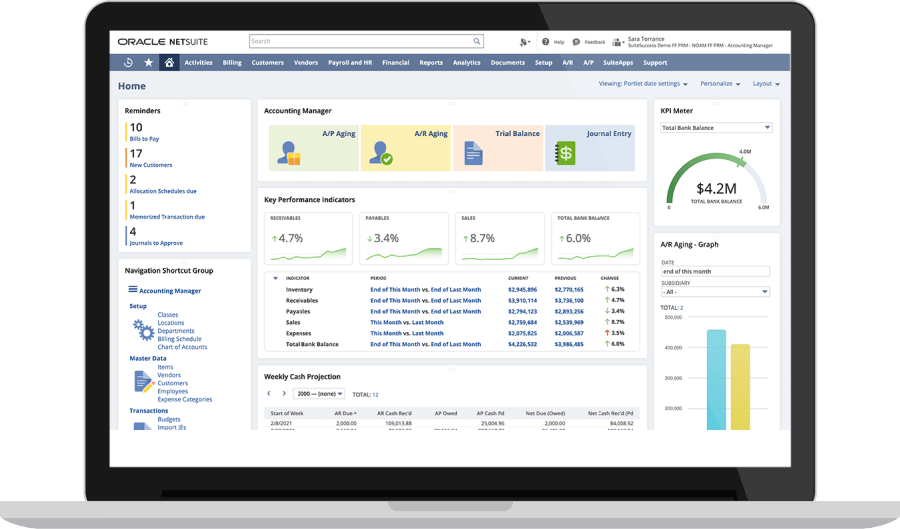
Expedite daily financial transactions, accelerate the financial close process and ensure compliance. Get a complete, real-time view of your business’s financial performance, from a consolidated level down to individual transactions.
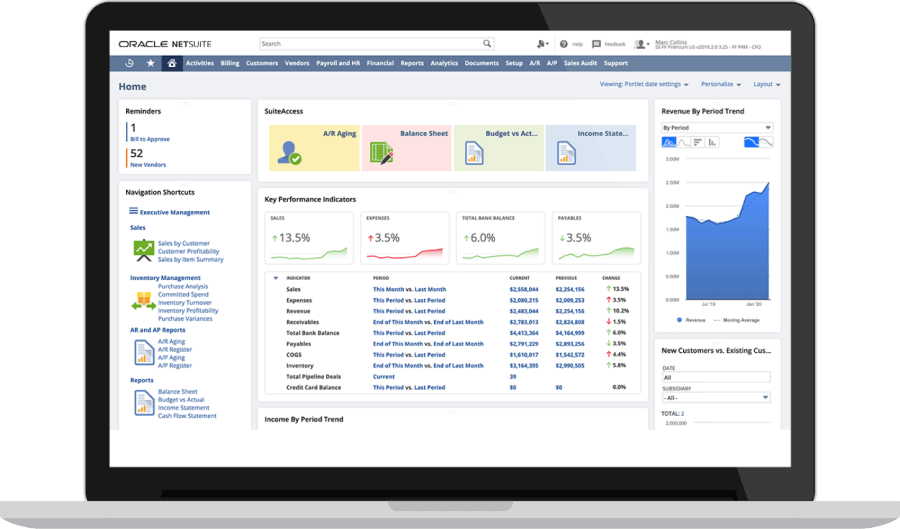
NetSuite OneWorld helps companies manage global operations, including multiple currencies, taxation rules and reporting requirements, across geographies and subsidiaries, all while providing real-time financial consolidation and visibility.
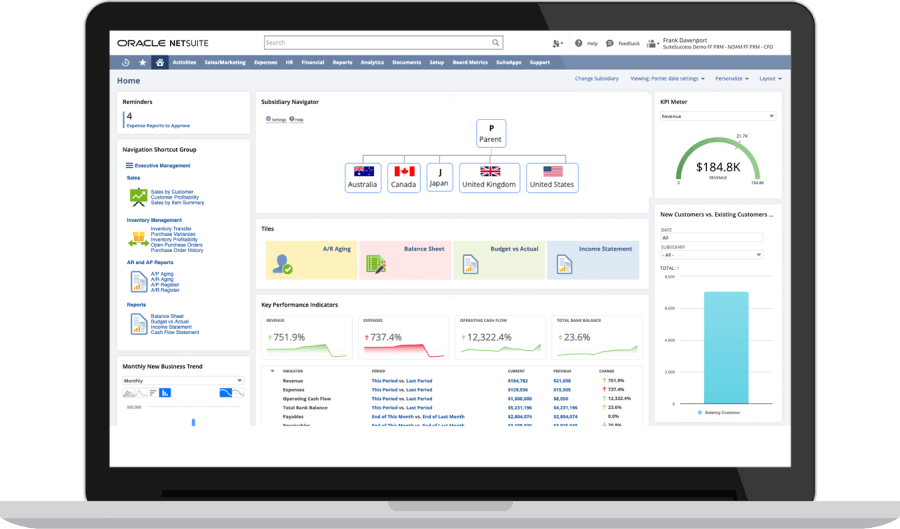
NetSuite Enterprise Performance Management brings together planning, budgeting, forecasting, account reconciliation, financial close, and reporting processes from across the entire organization.
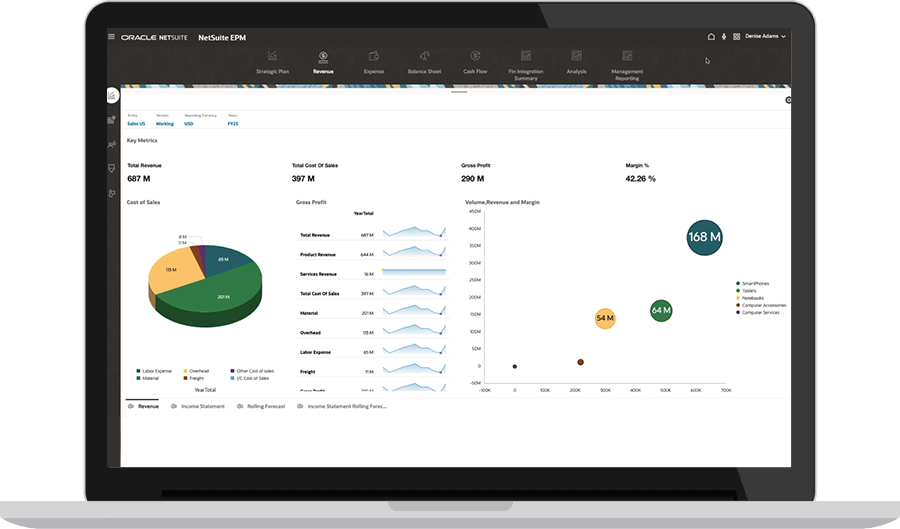
Automate the management of your inventory. Keep inventory costs low while meeting customer delivery expectations. NetSuite delivers tools for tracking inventory in multiple locations, determining reorder points, managing replenishment and optimizing safety stock.
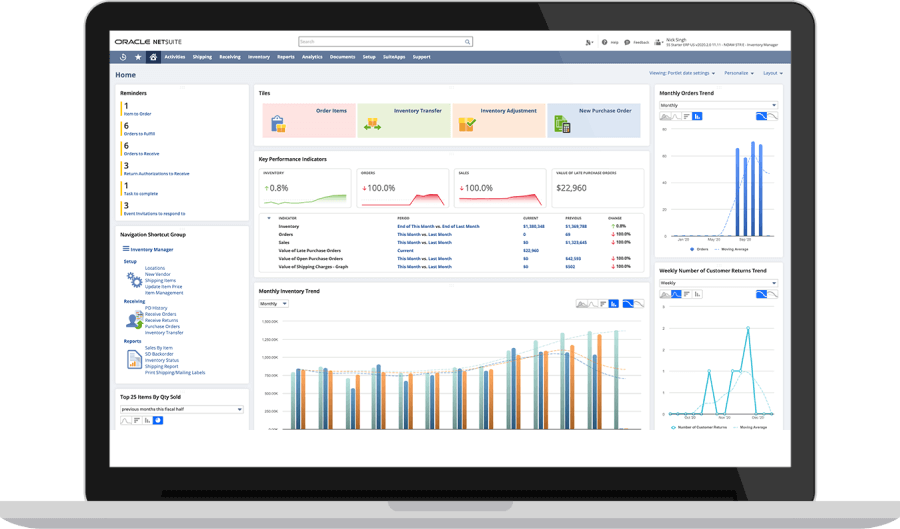
Streamline order processing by eliminating manual bottlenecks, preventing errors and establishing a smooth flow from sales quote to order fulfillment. The result: timely invoicing and payment.
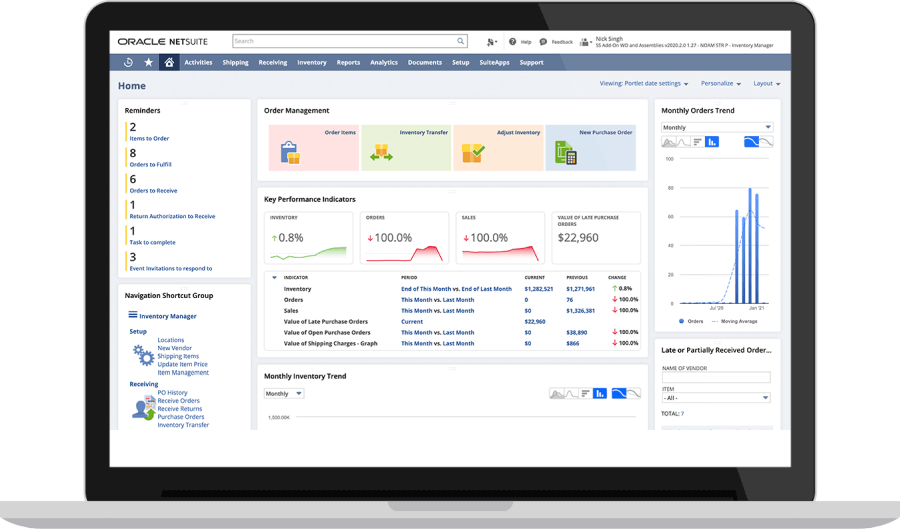
Where an item is produced or stored shouldn't keep a business from meeting customer needs. NetSuite eases the process of moving goods or materials through an extended supply chain.
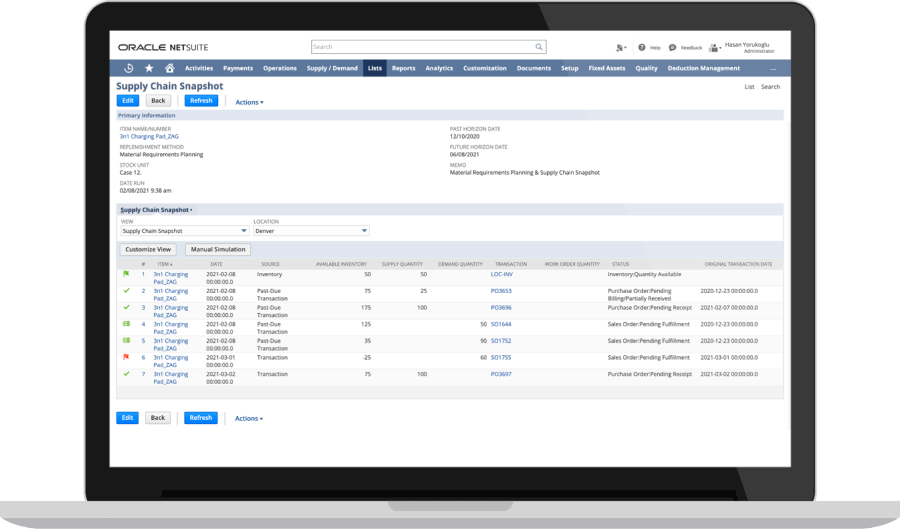
Optimize warehouse operations with RF-device-directed putaway and picking tasks, driven by customized, user-defined strategies and advanced capabilities like wave management, cartonization, cycle count planning, real-time inventory updates and shipping system integrations.
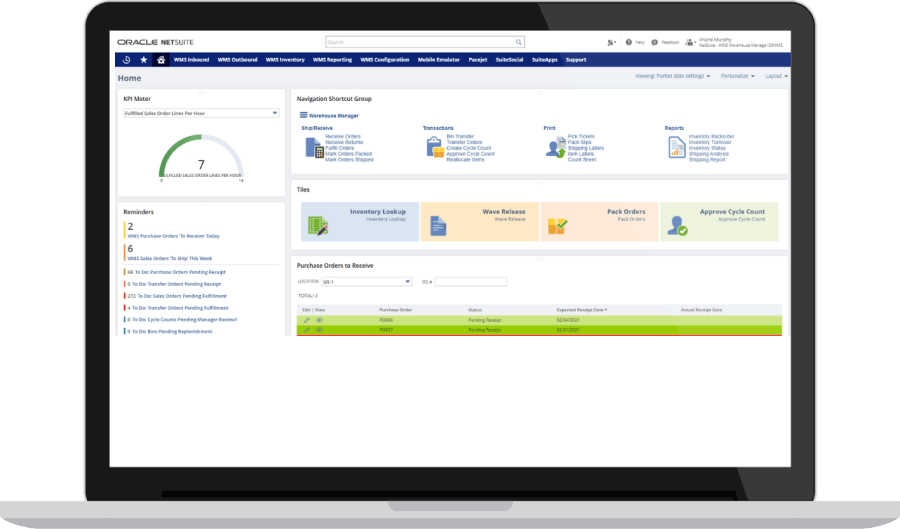
Buy goods and services at the best price and in a timely manner. Save time, reduce costs and improve visibility into spending and vendor performance by centrally managing procurement. Ensure clear communication throughout the procure-to-pay process.

Challenges NetSuite ERP Solves

- Manual Processes. Automate and streamline manual processes that waste time and resources.
- Data Accessibility. Quickly and easily access real-time data across the organization.
- Data Integrity. Provide stakeholders with timely, accurate financial statements, inventory reports and more.
- Meeting Expectations. Deliver promised order accuracy, on-time delivery and cost savings.
- Balancing Supply and Demand. Manage supply chains in the face of rapid change, rising costs and shifting buyer behavior.
- Inventory Insights. Plan and balance inventory to meet demand.
Faster Time to Value
NetSuite has packaged the experience gained from tens of thousands of worldwide deployments over two decades into a set of leading practices that pave a clear path to success and are proven to deliver rapid business value. With NetSuite, you go live in a predictable timeframe — smart, stepped implementations begin with sales and span the entire customer lifecycle, so there’s continuity from sales to services to support.

How Much Does NetSuite ERP Cost?
Companies of every size, from pre-revenue startups to fast-growing businesses, have made the move to NetSuite. Looking for a better way to run your business but wondering about the cost?
Users subscribe to NetSuite for an annual license fee. Your license is made up of three main components: core platform, optional modules and the number of users. There is also a one-time implementation fee for initial setup. As your business grows, you can easily activate new modules and add users — that’s the beauty of cloud software.
Get started now with Industry Editions of NetSuite ERP that include accounting capabilities and modules to address industry-specific needs.
Contact NetSuite Now (opens in new tab)

Customer Stories
Product demos, guides & blogs, essential learning.

Data Sheets
Access specifications, features and benefits of NetSuite ERP.
- NetSuite OneWorld (opens in new tab)
- NetSuite Inventory Management (opens in new tab)
- NetSuite Order Management (opens in new tab)
- NetSuite WMS (opens in new tab)

Spark ideas with success stories from NetSuite customers.
- Ambassador Foods Uses ERP to Help International Food Manufactures Break Into the U.S. Market (opens in new tab)
- Lift Off: Easy Living Elevators Shares Its Cloud ERP Implementation Lessons (opens in new tab)
- JPC Equestrian Gallops Into this Year’s Holiday Season (opens in new tab)
- Ryan’s Pet Supplies Makes a Seamless Transition to the New Rules of Retail (opens in new tab)

See NetSuite ERP in action.
- NetSuite Financial Management
- NetSuite Item Management
- NetSuite Order Management
- NetSuite Purchase Management
- NetSuite Quote Management

View our on-demand webinars, which deliver insights from NetSuite and industry experts.
- Making the Switch: From QuickBooks to NetSuite (opens in new tab)

Go deep into topics around NetSuite ERP.
- 7 Ways Cloud ERP Helps Businesses Build Resilience and Agility (Guide) (opens in new tab)
- The Value of a True Cloud ERP Platform (Guide) (opens in new tab)

Discover best practices and learn more about enterprise resource planning from beginner to advanced levels.
- What is ERP? (Video)
- 9 Key ERP Implementation Best Practices (Article)
- ERP Modules: Types, Features & Functions (Article)
- Buying an ERP System: Features, Benefits and Reasons You Should (Article)
- Pros and Cons of Using an ERP (Article)
Before you go...
Discover the products that 37,000+ customers depend on to fuel their growth.
Before you go. Talk with our team or check out these resources.
Want to set up a chat later? Let us do the lifting.
NetSuite ERP
Explore what NetSuite ERP can do for you.
Business Guide
Complete Guide to Cloud ERP Implementation

IMAGES
VIDEO
COMMENTS
SAP Business Planning and Consolidation is embedded within SAP S/4HANA on-premise, enabling real time plan-to-actual analysis and consolidations. Hybrid planning with SAP Analytics Cloud Extend SAP Business Planning and Consolidation with additional visualization, enhanced planning, and predictive capabilities with SAP Analytics Cloud.
Modern planners require the ability to analyze and simulate outcomes with analytics and predictive capabilities while working with trusted data. Through real-time connectivity, planners can act in the moment to drive better decisions with a modern cloud planning solution. Get the support you need to move to SAP Analytics Cloud today.
SAP Analytics Cloud. SAP Analytics Cloud is an all-in-one analytics platform for organizational planning, predictive analytics, and visualized business intelligence. Now the data integration between SAP Analytics Cloud and SAP BPC has been . 6 PUBLIC Application Help - SAP Business Planning and Consolidation, version for SAP BW/4HANA
SAP Business Planning and Consolidation to SAP Analytics Cloud Migration Guide. The guide is targeted for customers who have deployed SAP Business Planning and Consolidations (SAP BPC Standard configuration, supported versions) and applies to all underlying database versions (HANA and non HANA). Download the Document.
SAP Business Planning and Consolidation (BPC) is a powerful solution that can help streamline financial processes, providing businesses with the tools they need to thrive in a competitive landscape. 1. The Importance of Financial Planning and Consolidation. Financial planning and consolidation involve the management of an organization's ...
Business Planning and Consolidation (BPC) has long been SAP's flagship product for planning and consolidation. With SAP's market strategy of going to the cloud, SAP Analytics Cloud (SAC) Planning and Group Reporting are now the preferred platforms over BPC. One of the strengths and value propositions of BPC was to have one integrated solution for consolidations and planning.
SAP S/4HANA Cloud is a modular cloud ERP software designed for every business need - powered by AI and analytics. SAP S/4HANA Cloud enables users to run mission-critical operations in real time from anywhere, introduce new business models in an industry, and expand globally. It can be deployed either on premise, in the cloud, or in a hybrid ...
SAP Business Planning and Consolidation, version for SAP BW/4HANA Document Version: 11.1 SPS00 - 2020-03-09 ... SAP Analytics Cloud. SAP Analytics Cloud is an all-in-one analytics platform for organizational planning, predictive analytics, and visualized business intelligence. Now the data integration between SAP Analytics Cloud and SAP BPC ...
03-09-20236:02 PM. For the last more than 15 years, SAP Business Planning and Consolidaiton (SAP BPC) provided a rock-solid on-premise planning solution for customers. When organizations transitioned to cloud technology, SAP was able to satisfy that need with SAP Analytics Cloud, its flagship analytics and planning SAAS solution.
Application Help. Application help and technical information for SAP EPM solutions, add-in for Microsoft Office, which provides Data Manager functionality and integration with Microsoft Word, PowerPoint, and Excel within Business Planning and Consolidation. Includes all BPC 11.0 and BPC 11.1 documents such as application help, installation ...
SAP BPC (Budget Planning & Consolidation) is a key component of SAP's EPM suite that offers enterprise budget planning and consolidation tools that simplify the enterprise budget planning process and help measure ongoing corporate performance against forecasts. It allows what-if forecasting, helps accelerate budget and closing cycles and ...
In 2025, the group intends to conduct proof of concepts for SAP Analytics Cloud for planning. It will use the data in SAP Datasphere to evaluate the migration from the embedded SAP Business Planning and Consolidation, version for SAP BW/4HANA to the planning capabilities. For secure file transfer protocol (SFTP) development, it's hoping to ...
Overview. In this live session you will see how to import data from SAP Business Planning and Consolidation (BPC) Standard to create new models, or to add data to existing models. The session will also use SAP Analytics Cloud as a BPC client extension, rather than the EPM Add-In, enhancing BPC data with SAC ' s advanced analysis and forecasting ...
This is the accurate software that helps our company in financial consolidation, where different business transactions are recorded together for smooth and reliable financial reporting. IBM Cognos Controller gives the appropriate way to automate the financial close and this provides informative financial results.
Enterprise Resource Planning Blogs by SAP Get insights and updates about cloud ERP and RISE with SAP, SAP S/4HANA and SAP S/4HANA Cloud, and more enterprise management capabilities with SAP blog posts. ... ("FSI") in the Consolidation process. In S/4HANA Cloud Public Edition, these FSI are mapped from the posted GL account number ...
After customers and user groups that adopted S/4HANA early accused SAP of bait-and-switch tactics, CIO editor-in-chief in Germany Martin Bayer recently sat with Christian Klein, CEO of the ...
Take control of your business with NetSuite ERP: Accounting, order, inventory, procurement, supply chain and warehouse management by the world's #1 cloud ERP provider. ... NetSuite ERP is an all-in-one cloud business management solution that helps organizations operate more effectively by automating core processes and providing real-time ...